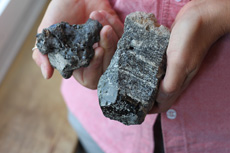Archaeological glass artefacts shed new light on Swedish glass history

Archaeological glass artefacts shed new light on Swedish glass history University of Gothenburg
Archaeologist Anna Ihr’s research has led to fascinating discoveries in two completely different regions of the world – in the old Swedish trade centre Old Lödöse along the Göta Älv river and in Qalhāt, the former capital of the Hormuz Kingdom in Oman. Ihr’s research shows that primary glass was produced in Sweden 300 years before the reign of King Gustav Vasa. It also shows that dried fish was once used to fuel ceramic kilns in Oman.
In Old Lödöse, Ihr has found pieces of a cracked clay crucible with glass remains inside and attached stones underneath. Nearly 100 kilos of this material has been uncovered.
‘The dating of my finds shows that glass was produced in Old Lödöse prior to 1260. That’s 300 years earlier than the previously oldest known written sources, which are from 1556. This means that Sweden’s history of glass production now has to be revised,’ she says.
The thesis describes how different vitrified, or glassy, materials can be interpreted and analysed. It can be very difficult to interpret how a piece of glass was made. It could have been made intentionally or unintentionally. Glaze is an example of intentionally produced glassy material.
Glass describes a state of a processed material. Vitrified slag from blast furnaces is one example of unintentionally material.
‘In order to determine the difference between intentionally and unintentionally processed materials, you need a certain type of scientific analysis which is very rarely performed in Scandinavia. This is the reason why glass never has been studied in this perspective in Sweden,’ says Ihr.
Three ceramic kilns have been located and excavated in Qalhāt. The analyses show that they were fuelled with dried fish, and the ashes and the minerals in the sand fused and formed a glassy slag, vitrifying the inside of the kilns.
‘The use of dried fish was a conscious choice, though.’
Ihr hopes that her doctoral thesis will contribute to a broader understanding of how certain societies were organised. In glass artefacts which reflect a well-structured community, as in Old Lödöse, archaeologists can extract traces of trade specialisation, technology, rituals and decision making – so called advanced societies.
In other cases, vitrified assemblages may reveal a community which-was not advanced. One example of this is the vitrified dung found in an old settlement in South Africa.
‘My studies show that glass production may be used as an indicator of an advanced society. From processed materials it is possible to extrat imanent social information, which may say much of a lost society' says Anna Ihr.
More information:
Anna Ihr, tel. +46 (0)739 51 05 30, e-mail ihr.anna@gmail.com
Title of the doctoral thesis: Becoming Vitrified. Kilns, furnaces and high temperature production
Faculty examiner: Liisa Seppänen
The thesis is available at http://hdl.handle.net/2077/35772
http://hum.gu.se/english/current/news/Nyhet_detalj/?languageId=100001&conten…
Media Contact
All latest news from the category: Earth Sciences
Earth Sciences (also referred to as Geosciences), which deals with basic issues surrounding our planet, plays a vital role in the area of energy and raw materials supply.
Earth Sciences comprises subjects such as geology, geography, geological informatics, paleontology, mineralogy, petrography, crystallography, geophysics, geodesy, glaciology, cartography, photogrammetry, meteorology and seismology, early-warning systems, earthquake research and polar research.
Newest articles

NASA: Mystery of life’s handedness deepens
The mystery of why life uses molecules with specific orientations has deepened with a NASA-funded discovery that RNA — a key molecule thought to have potentially held the instructions for…

What are the effects of historic lithium mining on water quality?
Study reveals low levels of common contaminants but high levels of other elements in waters associated with an abandoned lithium mine. Lithium ore and mining waste from a historic lithium…

Quantum-inspired design boosts efficiency of heat-to-electricity conversion
Rice engineers take unconventional route to improving thermophotovoltaic systems. Researchers at Rice University have found a new way to improve a key element of thermophotovoltaic (TPV) systems, which convert heat…



